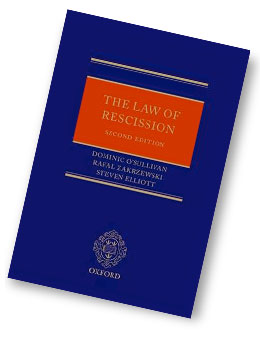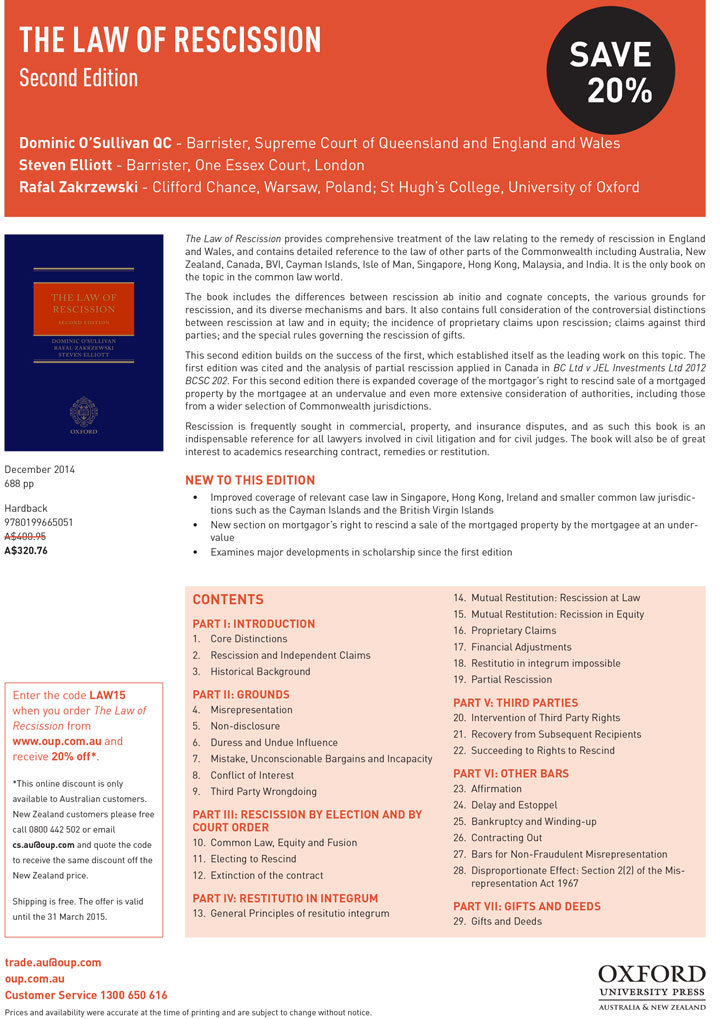Dominic O’Sullivan and his co-authors undertook an ambitious task in producing a book about rescission. No book had been written about rescission for almost a century: a warning in itself. And the scope of their book was larger than the two works that were produced in 1916. The doyen of the law of remedies, Professor Waddams, wrote:
“Rescission is an untidy subject. It tends to cut across legal divisions and categories, including contract, gift, property, unjust enrichment, and fiduciary obligations. It blurs the distinctions between law and equity and between rights and remedies. The subject does not lend itself to any single or simple over-arching theory, either as an explanation or justification of the past, or as a blueprint for the future. It is, no doubt, partly for these reasons that no book on the subject has appeared for nearly a century.”
The ambition of the authors of The Law of Rescission was matched by their ability.
We rightly admire any author of a book of academic distinction. Academics have to find time to write books between lecturing and marking exam papers and assignments. Barristers have to find time to write books between reading briefs, getting cases ready for court, conferences with solicitors and appearing in court. And good barristers like Dominic O’Sullivan are so popular, and so busy, it is not surprising that they rarely find time to write books. But some exceptional lawyers do: Meagher, Gummow & Lehane, and their successors-in-title, Mr Dyson Heydon and Mr Keith Mason to name but a few.
Those who have established themselves at the Bar may find it easier to find time to write a book. But Dominic was starting at the Bar in Brisbane, with a young family to support, when he wrote the first edition of this book; and that made his achievement even more impressive. I had the privilege to see him working on the drafts of the many chapters he wrote, as he squatted in the corner of my room, while establishing himself at The Bar.
It is one thing to produce another book on contract, or torts, where one can seek to improve on existing works, and dare I say it, copy their ideas provided you do not copy their words. It is quite another thing to write a work on a topic where no one has ventured. The Law of Rescission is an original work: by necessity.
It has its origins in Dominic’s doctoral thesis at Oxford. Doctorates depend on a thesis being an original contribution to learning. And when we think of great books based on doctorates, we reflect on the works of McPherson and Finn, whose commanding works also had their origins in a doctoral thesis.
The first edition of The Law of Rescission received high praise. Lord Walker described it as “a remarkable work of practical scholarship”. Justice Young found it “a tremendously impressive work.” Justice Keane remarked on “the powerful organising intelligence of the kind exhibited in this book”, as well as the wisdom collected in it. Justice Leeming described it as being in a class of its own, and wrote that “its approach is to describe the law as it is, followed by unsparing critical commentary”. Professor Barker confidently predicted that it would come “to be regarded as a Goff and Jones of its field — the first, comprehensive and truly modern exercise in cataloguing, organising and critically analysing a broad range of authority on a subject-matter hitherto dispersed and obscure.”
Having produced such a beautiful baby (and let’s face it, not all babies or books are beautiful), who could ask for more?
A publisher could, and hence the demand for a younger sibling.
Sir Edmund Hilary was famous for climbing Mt Everest. He did not have to prove that he could do it again. But authors of great legal texts are faced with the inevitable demand to produce a second edition, to take account of new case law and new scholarly works.
Dominic has risen to the challenge, and climbed the mountain again. Seven years after conquering the subject, he has done so again. But in different circumstances: he has achieved great professional success through hard work and intellectual rigour, and recently become a member of the senior bar. Whilst building a successful practice in Australia and overseas, he has devoted himself to the professional improvement of his colleagues, as one of the main drivers of the Current Legal Issues Seminars. And he has found time, somehow, to produce a second edition.
As the learned authors wrote in the preface to the first edition “Rescission is complex not least because it straddles the jurisdictional divide between the common law and equity and because it can involve both personal and proprietary rights”.
A work of this kind does more than catalogue cases. It clarifies, by making clear distinctions between termination ab initio, and termination for breach or frustration; the distinction between void and voidable contracts and other key distinctions. Chapter 3 deals with the historical fact that the courts of common law developed separate and distinct doctrines of rescission. Chapter 10, titled “Common Law, Equity and Fusion” returns to this topic, and declares that there remain two distinct kinds of rescission: one has common law origins and the other has equitable origins.
The practical significance of this, as Mr O’Sullivan, points out, with his usual clarity, is that one is a self-help remedy: the right to rescind by election. It is available in a narrow class of cases; whereas equitable rescission is available on additional grounds, and depends on a court order. He persuasively explains why the distinction should be maintained. These chapters, indeed the whole book, illustrate the deep analysis of principle.
The views expressed are not those of an adherent to some Phillip Street sect. Nor are they the work of a disciple of the late Professor Peter Birks, who supervised Dominic’s thesis. They are the views of an independent scholar, learned in the law and its history, who sees the utility of maintaining distinctions that have value.
At the risk of sounding like I am giving a reading from the gospel according to St Dominic, let me read one paragraph that illustrates the learning and wisdom to which I refer:
“In the vast majority of cases rescission is a remedy administered by the court acting on equitable principles and in a manner sensitive to the particular circumstances of the case. That is as it should be. The more powerful species of self-help rescission is in practice restricted to discrete classes of case in which its availability is appropriate. Properly understood, the law is not in need of reform. Whilst the promise of simplicity may at first make fusion attractive, upon closer examination the dualism that exists seems to be both useful and just. The preferable way forward is for incremental development of the doctrines of rescission at law and in equity with a clear eye to the differences between them, always sensitive to the strong policy considerations that underpin how the law should respond to impaired transactional autonomy.”1
The second edition, like the first, is a monumental work of scholarship. I congratulate its authors, and their closest supporters. I thank the publisher, Oxford University Press, for insisting that the 2007 work should not be an only child. I sincerely thank our hosts, Dr O’Sullivan QC and the Supreme Court Library, for organising this function.
I felt privileged to be asked by a scholar and practitioner of Dominic’s standing to launch the second edition. It gives me great pleasure to welcome into the world this second beautiful baby: the second edition of The Law of Rescission.
Justice Peter Applegarth
Footnote
- O’Sullivan, Elliott and Zakrzewski The Law of Rescission (2nd ed) Oxford University Press 2014 [10.19].




